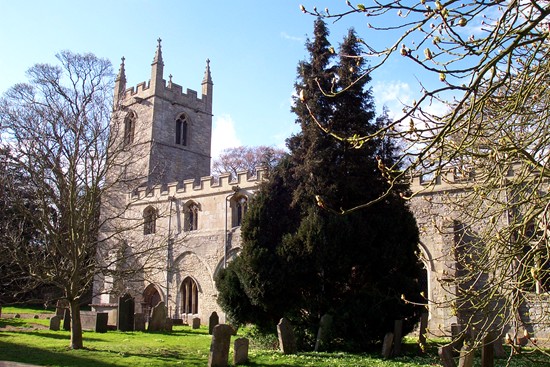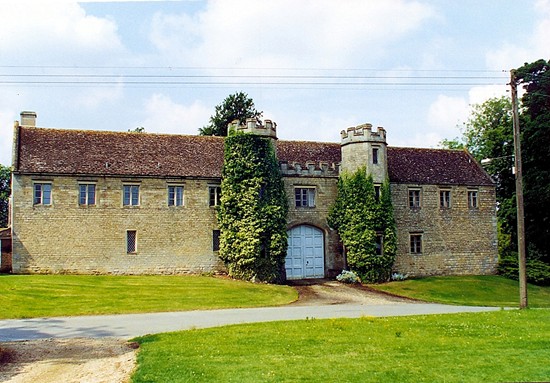|
Irnham
A visit to the village of Irnham, six miles north west of Bourne, is a step back in time because it has been unchanged for a hundred years making it one of the most visually pleasing villages in Lincolnshire. This was one of the 15 manors given by William the Conqueror to Ralph Pagnell and is mentioned in the Domesday Book. Today, four roads meet here yet there is little through traffic to disturb the peace of this self-contained grey stone village set among tall trees in a fold of the hills. It consists of friendly cottages, a spacious old church dating back to the 12th century, a Tudor hall on the edge of a woodland park and an attractive inn, the Griffin, which stands at the crossroads and is mostly Georgian. The family who once held the manor here also owned the Luttrell Psalter, bought by Pierpont Morgan for £30,000 and now in the British Museum. Sir Andrew Luttrell, fifth Baron of Irnham, has not only a canopied tomb in the village church but also an enormous brass from 1390. A smaller brass of a knight nearby is thought to have been intended for Sir Geoffrey Hilton who died about 1440 after his family had succeeded the Luttrells. The Irnham estate passed by marriage to Sir Richard de Thimelby who built the present L-shaped hall in 1510.
St Andrew's Church has dominated village life since Norman times and examples of Early English, Decorated and Perpendicular work can be seen with many later additions together with an exceptional Easter sepulchre and a Victorian east window of 1859. But by the end of the 20th century, it became clear that the building needed major restoration, particularly the roof, last repaired in 1858, and electrical wiring installed in 1960 which was becoming dangerous. An appeal committee was formed by the parochial church council in 2000 and funds were sought from various sources for the £250,000 needed with donations coming from English Heritage and the Prince of Wales while more money was raised by parishioners with a series of events such as fetes, auctions and harvest suppers. Work was completed in 2004 and commemorated with a service of thanksgiving on Sunday 25th July conducted by the priest in charge, the Rev Margaret Barton. An unexpected bonus was the revival of bell ringing, a feature of church life in the past but which had been dormant for 30 years. Churchwarden Charles Leggatt was enthusiastic about their achievement: "The church was last restored in 1858 and now we have done it again", he said. "It has been a privilege to be the custodians who have grasped the nettle and carried out the work and we hope it survives for another 100 years."
All owners of Irnham were Roman Catholic until the estate was sold in 1854 to William Hervey Woodhouse, a Liverpool wine merchant and when he died in 1859, the estate passed to his only daughter, Isabel Hervey Woodhouse. Half a century later, it was bought by Sir Frederick Benton Jones whose descendants still live there. This continuity of family ownership has resulted in the survival of the original mansion almost intact although the interior of the north wing was gutted by fire in 1887 and has since been well restored. In the thickness of an upstairs wall is a fine priest's hole entered through a step in the staircase which swings open on a hinge. This probably dates from the time of Queen Elizabeth's persecution of the Catholics. It was first discovered in 1858, the year the house was sold when a crucifix and palliasse bed were found inside. Later in the century, the secret chamber was extensively explored and the Stamford Mercury reported on Friday 6th May 1892: "Workmen recently cut through one of the walls of this chamber and a spacious ventilating shaft was discovered. It has a height of 30ft. and opens out through a well-built cylindrical shaft above the roof. The use of this shaft has puzzled many but it is now understood. Undoubtedly, the shaft was the only means of ventilation to the poor people who might be hiding in the troublous times of the 16th century. The chamber itself is ingeniously formed between a number of inner walls: it has a floor space of about 9ft. by 5ft. and a height of 10ft. It was approached through a door formed by a hinged step - one of four leading to a room of the top storey of the ancient building." Further evidence of Irnham's religious past can be found at St Andrew's Church where two 18th century Roman Catholic priests lie buried in the churchyard. The church is a grand building with Norman, early English, Decorated and Perpendicular work and largely hidden by trees close to the grounds of the hall. Visitors are drawn here by an exceptional Easter sepulchre and a vivid Victorian east window of 1859 while brass rubbers also come to copy two mediaeval brasses.
REVISED AUGUST 2015 See also
Sir Henry Clifford V C Village cricket
One of England's favourite villages Irnham in past times
Go to: Main Index Villages Index |
|||||||||||||||||










